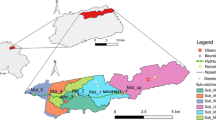Abstract
Water quality parameters interact in nature in complex ways. An example of this complex interaction is the dependence of nutrient concentration on temperature, pH, dissolved oxygen, etc. This research presents a computational exploration of the dependence of several water quality variables on chlorophyll-a (chl-a) and phytoplankton. WASP water quality estimations for Nitrate (NO3), Phosphate (PO4), Ammonia (NH3), Dissolved Oxygen (DO), and biochemical oxygen demand (BOD) were produced and the results were analyzed to determine the dependence of those variables on several water quality boundary conditions. The analysis was performed for the period December 31, 1998, to April 30, 1999. The paper shows how crucial are the seaward boundary data (in particular those of chl-a and phytoplankton) on the kinetics of water quality constituents in a coastal estuary.
Access this chapter
Tax calculation will be finalised at checkout
Purchases are for personal use only
Preview
Unable to display preview. Download preview PDF.
Similar content being viewed by others
References
Yokel, B.J.: Estuarine water quality. The Conservation Fund. Study No 3. Washington DC (1975)
O’Connor, D.J., Thomann, R.V., DiToro, D.M.: Dynamic water quality forecasting and management. USEPA Report 660/3-73-009. Washington DC (1973)
National Research Council, Clean coastal waters. National Academy Press, Washington DC (2000)
Mojzis, A.K., Redalje, D.G.: Bacterioplankton abundances in the Saint Louis Bay. In: Northern Gulf Institute 2010 Annual Conference, May 18-20. Mobile, Alabama (2010), http://www.northerngulfinstitute.org/outreach/conferences/2010/posters/24_Mojzis_06-USM-03_Poster.pdf
Wool, T.A., Ambrose, R.B., Martin, J.L., Comer, E.A.: Water Quality Analysis Simulation Program, WASP (2013), http://sdi.odu.edu/mbin/wasp/win/wasp6_manual.pdf
Kieffer, J.: Development of a nutrient and dissolved oxygen water quality model for the Saint Louis Bay watershed. Dissertation. Mississippi State University (2002)
Hashim, N.B.: Watershed, hydrodynamic, and water quality models for total maximum daily load St. Louis Bay watershed Mississippi. Dissertation. Mississippi State University (2001)
Hamrick, J.M.: A three-dimensional environmental fluid dynamics computer code: Theoretical and computational aspects. Special Report 317 in Applied Marine Science and Ocean Engineering. The College of William and Mary, Virginia Institute of Marine Science, 63 p. (1992)
Environmental Protection Agency, EPA. The HSPF BMP toolkit (2013), http://www.epa.gov/athens/research/modeling/HSPFWebTools/
Wool, T.A., Davie, S.R., Rodriguez, H.: Development of 3-D hydrodynamic and WQ models to support total maximum daily load decision process for the Neuse River estuary. J. of Wat. Res. Plan. and Mgmt., ASCE 129(4), 295–306 (2003)
Author information
Authors and Affiliations
Editor information
Editors and Affiliations
Rights and permissions
Copyright information
© 2014 Springer International Publishing Switzerland
About this paper
Cite this paper
Alarcon, V.J. (2014). The Role of Boundary Conditions in Water Quality Modeling. In: Murgante, B., et al. Computational Science and Its Applications – ICCSA 2014. ICCSA 2014. Lecture Notes in Computer Science, vol 8581. Springer, Cham. https://doi.org/10.1007/978-3-319-09150-1_53
Download citation
DOI: https://doi.org/10.1007/978-3-319-09150-1_53
Publisher Name: Springer, Cham
Print ISBN: 978-3-319-09149-5
Online ISBN: 978-3-319-09150-1
eBook Packages: Computer ScienceComputer Science (R0)




